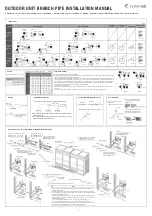
5
803161 Rev. 01
Optional Condensate Connection
If the wall sleeve is equipped with an indoor
condensate drain you will need to make the
connection to the field supplied drain system installed
under the wall sleeve. The unit’s outlet drain
connection stub is a 5/8” outside diameter tube for
connection to the drain tubing. The outlet drain
connection stub is sealed with a rubber plug as
shipped from the factory. Ensure the drain lines do
not kink or collapse during installation. Follow all
applicable local codes and ordinances regarding
condensate drainage and proper connection to a drain
system, including venting and trapping
considerations.
Heating/Cooling Chassis Installation
1.
Slide the chassis into the wall sleeve until firmly
seated against the seals. Push from the ends of the
front cover where they attach to the coil supports. Be
careful
NOT
to push the chassis from the electrical
box cover or middle of the front coil cover.
2.
There is a vertical air seal at the rear of the unit to
isolate the air path between the condenser inlet and
outlet. These seals will engage and “seal” against the
rear grille. However, in some cases, such as when an
extra deep wall sleeve is used, or some other sleeve
variation is encountered that prevents the vertical seal
from engaging against the outdoor grille, steps must
be taken to add anti-recirculation baffles to prevent
hot condenser air from short-circuiting back into the
air intake via the void space created in behind the
outdoor grill.
3.
If the optional condensate drain kit is used, install the
flexible tube from the chassis spigot to the wall
sleeve condensate drain by pressing the tube into the
drain assembly.
Caution
: when removing the chassis
remember first to lift the tube from the drain
assembly.
4.
If the unit is equipped with
Electronic controls
and
touchpad, locate the 24 Volt wiring harness coiled
beneath the control box. The harness is employed if a
remote 24 Volt AC wall thermostat will be used. If
so, connect the multi-wire 24 volt wiring harness to
the mating plug protruding beneath the control box,
as applicable, following the detailed instructions on
the particular wiring diagram affixed to the specific
unit being installed. Insulated crimp-on connectors
are provided at the end of every connection lead to
facilitate connections/insulation.
5.
If the unit is equipped with
Mechanical knob
controls
this variation cannot be adapted to work
with a remote thermostat.
6.
Set the manual damper operator in the open or closed
position depending on the desired operation.
7.
Plug the heat/cool chassis cord into the power
receptacle located either in the sub-base or the wall,
as applicable.
8.
Install the filter and front panel and secure it with the
two retaining screws located in its upper corners.
WARNING:
Operating the unit without the filter in
place can not only damage the unit, but also expose the
user to a hazard from rotating parts potentially
resulting in bodily injury. The filter is intended to be
removable with the use of a tool. The front panel
retains the filter, and 2 screws secure the front panel.
Always remember to re-install the filter after servicing
the chassis, or replacing/cleaning the filters.
9.
Wipe unit cabinet/wall sleeve to remove dirt, etc.
10.
The unit is now ready for operation, when supplied
with power from the distribution panel and wired to a
remote thermostat (if applicable).
START-UP CHECKLIST
Note: Once the unit is installed, it should be checked
for proper function by qualified service personnel
before turning it over to the User.
Circuit breakers, wire size, and electrical
connections tight and correct
Filter clean and properly in place
Condenser air inlet and outlet free of
obstructions and no short-circuiting of
condenser air
Unit operated for 20 minutes to prove stability
Controls operation OK
Unit installed in compliance with all codes and
ordinances
All panels in place and secured with required
fasteners
Mylar overlay applied to cover up touch pad
for 24 Volt Remote Thermostat installations.
Work area clean and free of debris
Owner or operator instructed on control
operation and routine maintenance.






























